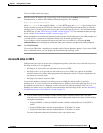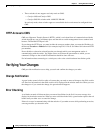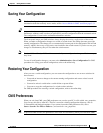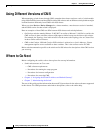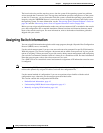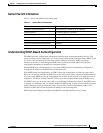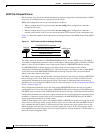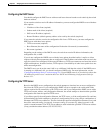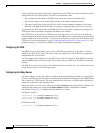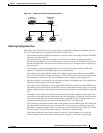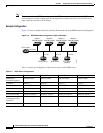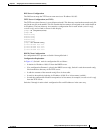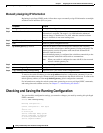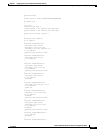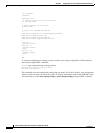
4-5
Catalyst 2950 Desktop Switch Software Configuration Guide
78-14982-01
Chapter 4 Assigning the Switch IP Address and Default Gateway
Assigning Switch Information
Configuring the DHCP Server
You should configure the DHCP server with reserved leases that are bound to each switch by the switch
hardware address.
If you want the switch to receive IP address information, you must configure the DHCP server with these
lease options:
• IP address of the client (required)
• Subnet mask of the client (required)
• DNS server IP address (optional)
• Router IP address (default gateway address to be used by the switch) (required)
If you want the switch to receive the configuration file from a TFTP server, you must configure the
DHCP server with these lease options:
• TFTP server name (required)
• Boot filename (the name of the configuration file that the client needs) (recommended)
• Host name (optional)
Depending on the settings of the DHCP server, the switch can receive IP address information, the
configuration file, or both.
If you do not configure the DHCP server with the lease options described earlier, it replies to client
requests with only those parameters that are configured. If the IP address and subnet mask are not in the
reply, the switch is not configured. If the router IP address or TFTP server name are not found, the switch
might send broadcast, instead of unicast, TFTP requests. Unavailability of other lease options does not
affect autoconfiguration.
The DHCP server can be on the same LAN or on a different LAN than the switch. If the DHCP server
is running on a different LAN, you should configure a DHCP relay. For more information, see the
“Configuring the Relay Device” section on page 4-6. If your DHCP server is a Cisco device, refer to the
“IP Addressing and Services” section in the Cisco IOS IP and IP Routing Configuration Guide for
Release 12.1.
Configuring the TFTP Server
Based on the DHCP server configuration, the switch attempts to download one or more configuration
files from the TFTP server. If you configured the DHCP server to respond to the switch with all the
options required for IP connectivity to the TFTP server, and if you configured the DHCP server with a
TFTP server name, address, and configuration filename, the switch attempts to download the specified
configuration file from the specified TFTP server.
If you did not specify the configuration filename, the TFTP server, or if the configuration file could not
be downloaded, the switch attempts to download a configuration file by using various combinations of
filenames and TFTP server addresses. The files include the specified configuration filename (if any) and
these files: network-config, cisconet.cfg, hostname.config, or hostname.cfg, where hostname is the
switch’s current hostname. The TFTP server addresses used include the specified TFTP server address
(if any) and the broadcast address (255.255.255.255).



